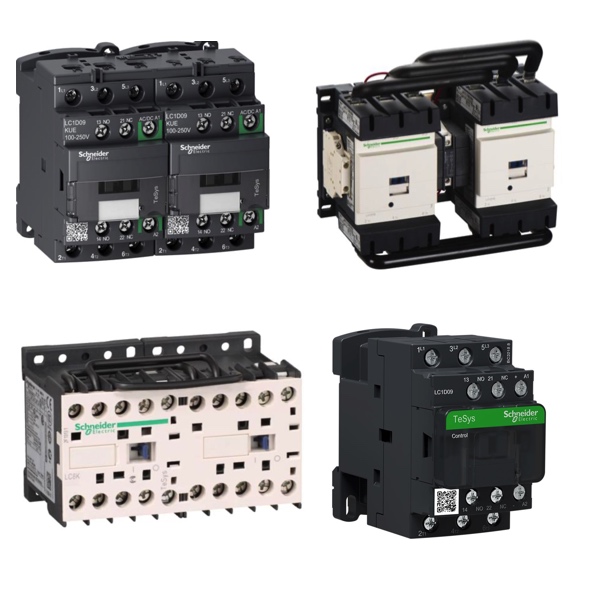IEC Reversing Contactors

Reversing contactors, also known as reversing starters or reverse contactors, are electrical devices used to control the direction of rotation of electric motors. They are commonly employed in various applications where it is necessary to reverse the motor's direction, such as in industrial machinery, conveyor systems, elevators, and more.
The main function of a reversing contactor is to swap the connections of the motor's phases, effectively reversing the polarity and allowing the motor to rotate in the opposite direction. This is achieved by using a combination of power contacts, auxiliary contacts, and mechanical interlocks.
IEC reversing contactors are contactors that comply with the standards set by the International Electrotechnical Commission (IEC) for controlling the operation of electric motors in both forward and reverse directions. These contactors are widely used in various industrial applications where motor control and direction switching are required. It's important to note that IEC reversing contactors comply with specific standards and regulations established by the IEC, ensuring their compatibility and interoperability. However, it's crucial to consult the applicable local regulations and standards when selecting and installing IEC reversing contactors to ensure compliance with the electrical codes and requirements in your region.
More Information about Reversing Contactors
The reversing contactor consists of two contactors, often referred to as the forward contactor and the reverse contactor. These contactors are mechanically interlocked, which means that only one of them can be engaged at a time, ensuring that the motor can only run in one direction at a given time. The interlocking mechanism prevents both contactors from being energized simultaneously, which could lead to a short circuit.
In addition to the power contacts responsible for reversing the motor's direction, reversing contactors may also have auxiliary contacts. These auxiliary contacts are used for control signaling and interlocking with other devices or control circuits. They can be used to provide feedback or signal the status of the motor, enabling additional control and protection functions.
The working principle of a reversing contactor is based on the control of electrical power to the motor. When the control circuit is activated, the forward or reverse contactor is energized, depending on the desired direction of rotation. This completes the circuit and allows power to flow to the motor in the selected direction.
Reversing contactors are available in various sizes and voltage ratings to accommodate different motor sizes and power requirements. It's important to choose a reversing contactor that is properly rated to handle the voltage and current of the motor it will control.
Installing a reversing contactor involves connecting the appropriate power supply, load side wiring, and control circuit. The specific installation process may vary depending on the manufacturer and the application. It is recommended to follow the manufacturer's guidelines and wiring diagrams to ensure proper installation and safe operation.
Some advantages of using reversing contactors include their ability to easily change the motor's direction without manually swapping wires, their compatibility with standard motor control circuits, and their ability to provide reliable and efficient motor control.
Reversing contactors are electrical devices used to control the direction of rotation of electric motors. They employ mechanical interlocks and power contacts to reverse the motor's polarity and allow it to rotate in the opposite direction. Reversing contactors are essential in applications where the ability to change the motor's direction is required, ensuring efficient operation and versatility in various industrial and mechanical systems.
FAQs
What other applications and equipment would benefit from reversing contactors?
Reversing contactors find application in various equipment and systems where the ability to change the direction of rotation of an electric motor is necessary. Some of the applications and equipment that would benefit from reversing contactors include: industrial machinery, elevators, conveyor systems, winches, automatic gates, automated doors and automated robotic systems.
Motor Control Basics
Motor control allows operational control of electrical motors in various environments.
Motor control circuits provide a safe way to operate electrical motors. Back when motor control circuits were in their infancy, it would have been common to see a simple disconnect switch that would be used to turn on and off a motor. Depending on the size of the motor and how much voltage was required, operating this disconnect would have been dangerous, with a very high possibility of arcing or electrocution. Not to mention that when the disconnect was actuated, the large amount of inrush current would have damaged the motor over time.
In today's motor control circuits, there are a few common pieces of hardware.
A circuit breaker is used to protect the motor and any hardware downstream. A contactor and an overload relay are connected together and function in tandem to allow for remote and safe operation of the motor. The contactor functions much like a relay, allowing for a smaller electrical circuit to remotely close the motor contacts, starting the motor. The overload relay is designed to protect the motor in the case of a prolonged overcurrent event. These two devices are wired in series, so that if the overload relay detects an overcurrent event, the contactor will open the motor contacts, shutting off power to the motor.
The other two most common types of motor control hardware are a soft starter and a Variable Frequency Drive (VFD).
Both of these devices function in a similar way to the motor circuit with some added functions. The soft starter is designed to reduce large inrush current to the motor upon startup. This “soft starting” of the motor will prolong its life and allow for safer operation. The VFD performs the soft start functions, but also allows for speed control of the motor. This speed control is critical in many different environments and has made VFDs one of the most common and safe to use motor control circuits today.

